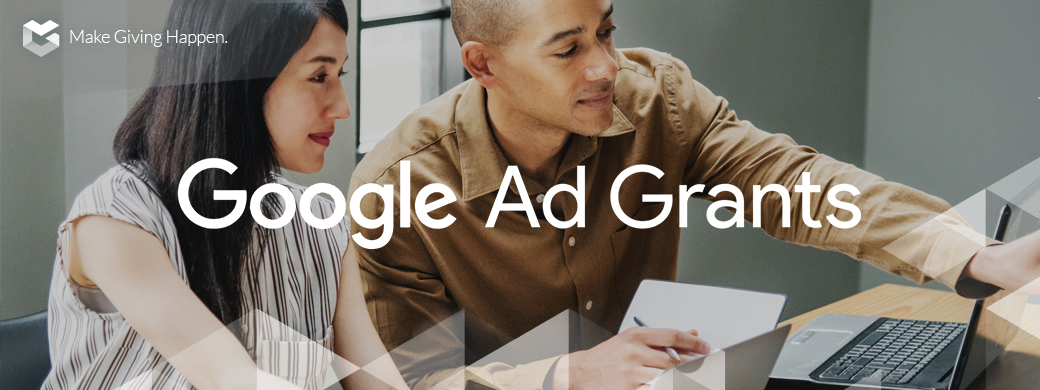Note: This is a follow up to our previous post about the Google Ad Grant. If you’re unfamiliar with the opportunity, click here for a primer.
Disclaimer: Make Giving Happen operates independently of Google Ad Grants and is not affiliated with Google. To apply for the Google Ad Grant, please visit https://www.google.ca/intl/en/grants/.
With a great grant comes great responsibility.
Google makes their setup as user-friendly as possible, but that does not mean it would not require effort on your part.
Marketing grants for non-profits are not common, so it is difficult to know how to capitalize on them. You do not necessarily need a digital marketing specialist on your team, but you need someone who will give the ad grant its due attention and be willing to invest in learning basic marketing tactics if they aren’t already familiar with them.
To properly leverage the ad grant, you must do your own keyword research, write your ads, create tracking, build your own links and control advanced settings such as keyword bidding, negative keywords, decide bidding and understand A/B testing. (Do not worry. That sounds more intimidating than it is.)
Google provides ample support to get you started, but before you submit your application, have a look and see if your organization is ready to make the leap into digital advertising.
Once we design our ads, where exactly are they going?
If you are looking for money to spend on ads across multiple websites and multiple platforms, look elsewhere. Google Ad Grants displays ads specifically on Google result pages.
This sounds limiting, but given the huge amount of traffic that goes through google – an estimated 40,000 searches per second, which adds up to a mammoth 3.5 billion searches per day, according to Internet live stats – that is powerful enough.
What do I need to know about keyword research?
If you start researching keywords, you may feel a bit overwhelmed. There seems to be a lot to know. But to get up and running, you just need to keep a few things in mind.
First, for your campaigns, decide on target keywords. You can use Google’s Keyword Planner tool to help you with this. Simply fill out the fields and look for ideas related to your subject matter.
Defined keywords help you write clear copy that is search-engine friendly and can guide you to the direction of your ads. Do not go purely for metrics and search volume – make sure your keywords align with your mission and message.
Metrics and search volume are important but make sure each Keyword aligns with your mission and message.
Keyword advertising is a highly lucrative business. Keywords can be rather competitive. Minimum bid per Keyword is 5 cents but Keywords can reach $50 per click. So it’s important to keep an eye on how many Keywords you include and how popular these words are.
Negative keywords help too – this helps prevent your ads from popping up in unrelated searches.
Dos and Don’ts
Dos
- DO Monitor your account. Google Ad Grants need you to maintain a 5% or higher click through If you fall below that for two months in a row, they’ll suspend your account.
That sounds like a low number, but once you start your campaign, you will realize it requires creating engaging and compelling content. And if your content is not working, that will mean changing your tactics.
- DO test new strategies. You may find a magic formula, but the nature of the internet is speed and change. Google lets you do A/B testing, which means you can run two campaigns at the same time and compare results – take advantage of it! You can reap the results of a successful campaign while testing your next approach.
- DO diversify your aims. It’s great to have a targeted aim for your campaigns (e.g. increase revenue). At the same time, do not limit yourself to one goal (or one campaign). For example, of course, you want to drive donations, but raising awareness of your organization and your work can be equally powerful. Having multiple campaigns with a specific goal is a great approach.
- DO FOCUS ON THE LONG GAME. It sounds like an investment at first, but Google Ad Grants reward the determined. After using ad grants, non-profits are eligible for grants pro – a whole $40 k to put towards ad spending.
Don’ts
- DO NOT try to target everybody. It seems that the more people you can advertise to, the better, right? Not exactly. With so much competition, It is better to focus on getting your ads in front of the niche of people who care about them. And not only that, it’s in the fine print. Google requires your account to use geo-tagging and limit your ads to geographic areas relevant to your organization.
- DO NOT use the grant for anything other than your non-profit mission. Google Ad Grants is insistent that it only be used for non-commercial ventures. Be sure to use your ad grants to support initiatives directly related to your charitable mission. Also, you can not solicit donations in the forms of property, car or boat.
- DO NOT panic if this all seems overwhelming. Google knows you may need a little help, and Adwords Express (one of the options when you’re setting up your account) offers you more built-in structure. You may be tempted to try and become an overnight expert and take full control over your campaigns, but do not discount the value of a little help from the very company that built the search engine.
Need some more guidance? Here at Make Giving Happen, we are all about meeting changemakers like you. If you’re looking for a solution to maximize your potential for your organization in correlation to Google Ad Grants, don’t hesitate to reach out! letsgetstarted@makegivinghappen.com
We look forward to connecting!

